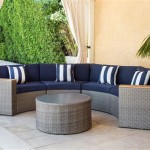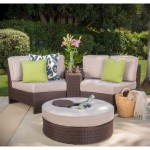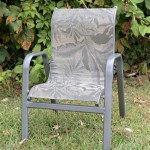Designing The Perfect Patio Furniture Layout: Planners and Principles
Creating an outdoor space that is both functional and aesthetically pleasing requires careful planning, especially when it comes to patio furniture layout. A haphazard arrangement can lead to an uncomfortable and underutilized area. Employing a patio furniture layout planner, whether a digital tool or a physical method, allows for visualizing different configurations and optimizing the space for relaxation, dining, entertaining, or a combination of these activities. This article explores key considerations and principles in designing the perfect patio furniture layout, assisting in transforming an outdoor area into a welcoming and functional extension of the home.
The successful design of a patio furniture layout hinges on understanding the available space. Accurate measurements are crucial. Measure the entire patio area, including any architectural features such as walls, columns, or built-in elements. Documenting these elements on a sketch or within a digital planning tool allows for accurate representation of the space constraints. This information acts as the foundation for all subsequent layout decisions. Ignoring accurate measurements frequently results in furniture that doesn't fit comfortably, hindering movement and detracting from the overall aesthetic.
Accurate measurement extends beyond the patio itself. Consider the access points to the patio, such as doors from the house or pathways from the garden. Ensure that furniture arrangements do not obstruct these pathways. Furthermore, note the placement of utilities, such as electrical outlets or water spigots. Access to these utilities might influence furniture placement, particularly for features like outdoor lighting or grills.
Beyond the immediate patio area, consider the surrounding landscape. Is the patio enclosed by a fence, open to a garden, or overlooking a view? The surrounding environment will significantly influence the type of furniture chosen and how it is arranged. For instance, a patio overlooking a scenic view might prioritize seating that maximizes the enjoyment of that view. Conversely, a patio bordering a busy street might require furniture that provides a degree of privacy and noise reduction.
Understanding Patio Functionality and Usage
Before selecting and arranging patio furniture, it's essential to define the primary purpose of the outdoor space. Is it primarily intended for dining, relaxation, entertaining, or a combination of these? The intended use case will directly dictate the type of furniture needed and how it should be arranged. A dining patio, for example, will require a table and chairs suitable for outdoor use, while a relaxation patio might feature lounge chairs, sofas, and perhaps a coffee table.
For a dining patio, consider the number of people typically using the space. A small table and chairs might suffice for a couple, while a larger table and seating arrangement will be necessary for entertaining guests. Consider the material of the table and chairs, opting for durable and weather-resistant options. Also, ensure sufficient space around the table for comfortable movement and for pulling chairs in and out.
A relaxation patio, on the other hand, requires furniture that promotes comfort and relaxation. Lounge chairs, sofas, and ottomans are common choices. Consider adding cushions and pillows for added comfort. A coffee table can provide a convenient surface for drinks, snacks, or books. Think about how the furniture arrangement fosters conversation and relaxation. Arrange seating to encourage interaction and create a comfortable flow within the space.
For patios intended for entertaining, a combination of dining and lounge areas might be appropriate. This allows for both dining and socializing. Consider creating distinct zones within the patio, each with its own furniture arrangement. For example, one area could feature a dining table and chairs, while another area could feature lounge seating and a fire pit. This provides flexibility for different types of gatherings.
Beyond the primary function, consider secondary uses for the patio. Is it necessary to accommodate children playing, pets relaxing, or hobbies like gardening? Incorporating these secondary uses into the design will add to the overall functionality and enjoyment of the space. For families with children, for example, consider including a play area or space for outdoor games. For pet owners, ensure sufficient shade and comfortable resting spots for pets.
Choosing the Right Furniture Scale and Style
Once the patio's functionality and usage are defined, selecting appropriately scaled furniture becomes crucial. The size of the furniture must be proportional to the size of the patio. Oversized furniture will overwhelm a small patio, making it feel cramped and uncomfortable. Conversely, undersized furniture will appear lost in a large patio, creating a sense of emptiness.
Before purchasing any furniture, measure the dimensions of each piece and visualize how it will fit within the patio space. Use masking tape to mark out the dimensions of the furniture on the patio floor. This provides a visual representation of the footprint of each piece and allows for adjusting the layout before making a purchase.
Ensure sufficient space for circulation around the furniture. A minimum of 36 inches of clearance is generally recommended for walkways and between furniture pieces. This allows for comfortable movement and prevents the patio from feeling congested. For dining areas, ensure sufficient space for pulling chairs in and out without bumping into other furniture or people.
Beyond scale, the style of the furniture should complement the overall aesthetic of the home and the surrounding landscape. Choose furniture that reflects personal taste and creates a cohesive look. Consider the materials, colors, and textures of the furniture. Wicker, teak, aluminum, and wrought iron are common materials for outdoor furniture, each with its own unique properties and aesthetic.
The color of the furniture should blend with the existing color palette of the home and landscape. Neutral colors like beige, gray, and white are versatile options that can be easily accessorized with colorful cushions and pillows. Consider the impact of sunlight on the furniture's color. Dark colors can absorb heat and become uncomfortable in direct sunlight, while light colors can reflect sunlight and create glare.
Consider the style of the surrounding landscape. A modern patio might benefit from sleek, minimalist furniture, while a traditional patio might be better suited to more ornate and classic designs. Integrating the furniture style with the overall environment creates a harmonious and visually appealing outdoor space.
Optimizing Patio Layout with Zoning and Traffic Flow
Effective zoning is integral to maximizing patio functionality. Dividing the patio into distinct zones based on intended use creates a more organized and appealing space. These zones can include a dining area, a lounging area, a cooking area (if applicable), and a play area. Each zone should be clearly defined by furniture arrangement and, potentially, by the addition of rugs or other visual cues.
The arrangement of furniture within each zone should be carefully considered. In a dining area, the table should be centrally located with chairs arranged around it. In a lounging area, seating should be arranged to encourage conversation and relaxation. Consider the placement of accessories like coffee tables, side tables, and lighting within each zone to enhance functionality and ambiance.
Traffic flow is another critical aspect of patio layout design. Ensure that there are clear and unobstructed pathways between zones and to access points such as doors and pathways. Avoid placing furniture in a way that blocks pathways or creates bottlenecks. Smooth and well-defined traffic flow promotes a comfortable and user-friendly patio experience.
Consider using plants, screens, or other architectural elements to define zones and direct traffic flow. Tall plants can create a visual barrier between a dining area and a lounging area. Screens can provide privacy and block wind. These elements can enhance the functionality and aesthetic appeal of the patio while improving traffic flow.
The placement of plants on a patio requires careful consideration. Plants can add beauty, shade, and privacy, but they can also obstruct pathways or create clutter. Choose plants that are appropriate for the patio's climate and lighting conditions. Arrange plants in a way that complements the furniture arrangement and enhances the overall aesthetic of the space.
Ultimately, designing the perfect patio furniture layout involves careful planning, attention to detail, and a clear understanding of the intended use of the space. By considering these principles, individuals can transform their outdoor area into a comfortable, functional, and aesthetically pleasing living space that enhances their enjoyment of their home.

Designing The Perfect Outdoor Oasis Patio Furniture Space Planning Ma

Create Your Dream Home Now Planner5d

Free Backyard Design Tool Revamp Your Outdoor Space

74 Best Patio Decor Ideas For Any Outdoor Space

Tips For Designing And Planning Your Dream Outdoor Living Area Patio360 Outdoors

74 Best Patio Decor Ideas For Any Outdoor Space

26 Best Patio Decorating Ideas Decor On A Budget

Good Planning Makes An Outdoor Design Perfect For Your Family

24 Backyard Makeover Ideas You Ll Love Extra Space Storage

Planning For Summer Entertaining In Winter
See Also








